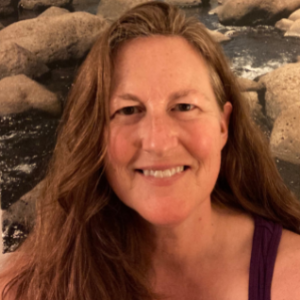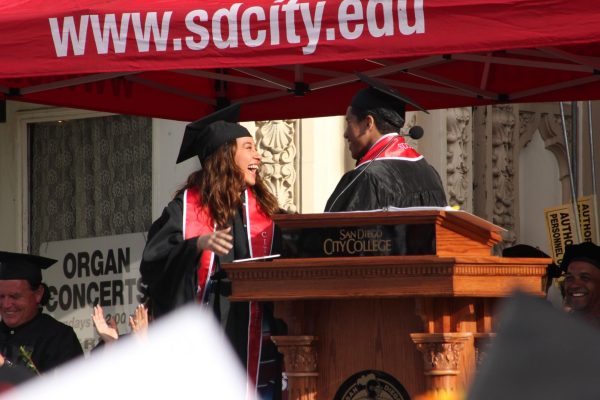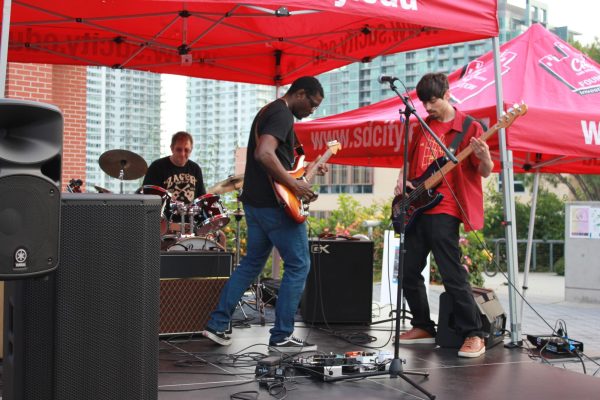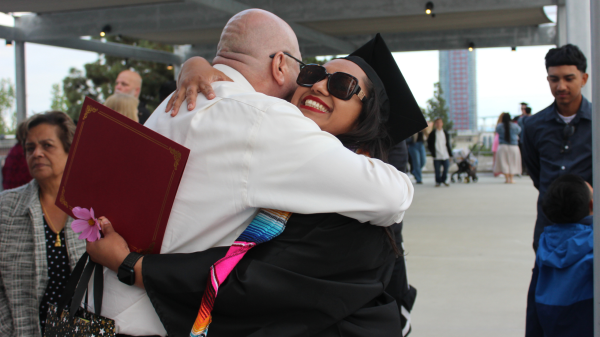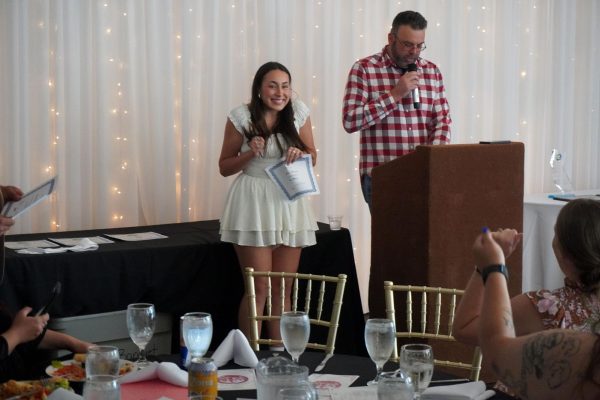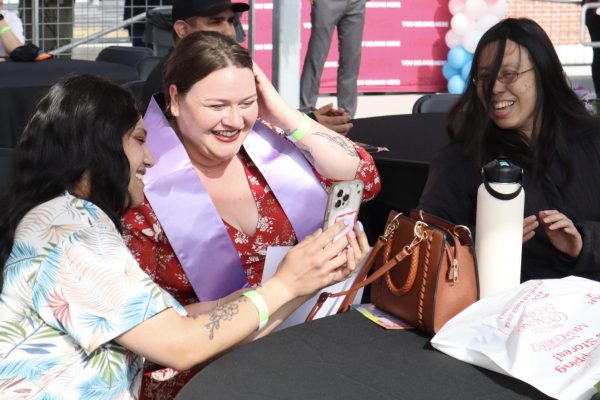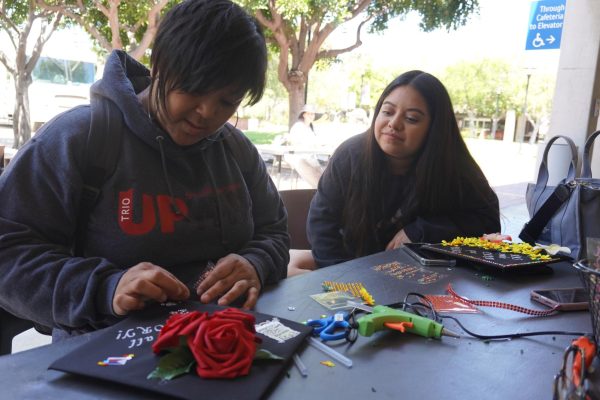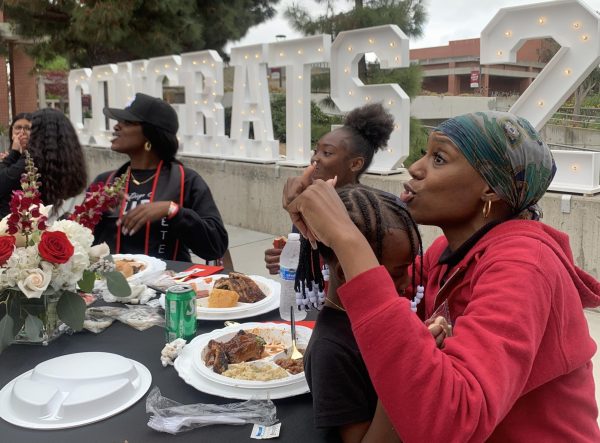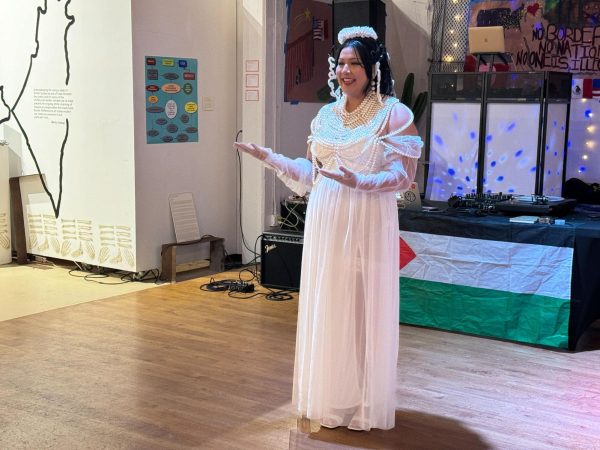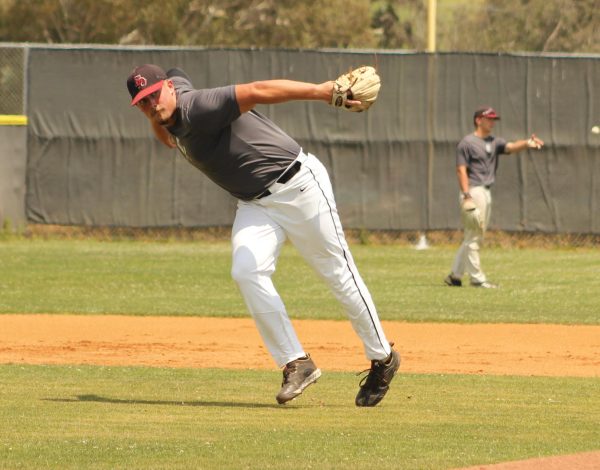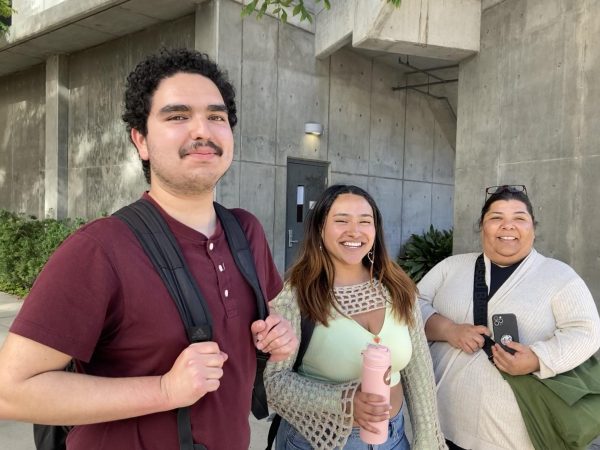City College Chicana/o Studies mural nears completion
An entire wall of the cafeteria will soon pay homage to the birth of the department and over 50 years of student activism
A new mural being painted on the wall of the cafeteria honoring the 50th anniversary of the Chicana/o Studies Department at San Diego City College features a giant conch shell, a symbol with multiple meanings in various cultures. Photo by Kathy Archibald/City Times Media
March 15, 2022
The rich, bold colors on the cafeteria wall embody the spirit that birthed the Chicana/o Studies Department at San Diego City College in 1970, portraying over 50 years of campus activism.
Funding for the project emerged serendipitously and savvy activists seized the opportunity.
When COVID-19 hit in March 2020, the in-person Chicano graduation ceremony was canceled. With funds remaining, City faculty acted on the persistent desire to celebrate the 50th anniversary of the Chicana/o Studies Department with a mural, according to Norell Martinez, an associate professor of English and Chicana/o studies at City.
Martinez said the committee resolved to find an artist in the Chicano arts community who understood San Diego history, including City College’s ties to Chicano Park.
They selected community muralist Alicia Siu, an artist renowned both internationally and locally who had experience in the type of work the committee wanted.
“We’re super happy and excited about her,” Martinez said.
Siu was raised in Honduras and identifies deeply with her Indigenous Nawat-Pipil heritage from her mother’s side. The Nawat-Pipil territory was ultimately colonized and lies within the country of El Salvador.
She holds a bachelor of arts degree in studio art and a master’s degree in Native American studies and has been painting murals for more than 20 years.
Siu, holding a wide tray with dollops of bright pink, blue and orange paints, described the deep meaning communities find in the conch shell displayed prominently at the center of the mural.
In some Indigenous cultures, the conch can be used in ceremonies, to call the community to meetings or invite rain. It can also refer to representational governance as opposed to hierarchical governance, she said.
Siu started the mural process at City by bringing together the community to learn what members wanted before ever bringing a pencil to paper or paint to a wall.
Though spearheaded by Chicana/o Studies faculty, others in the City College Chicana/o community were included in the planning process – students, counselors and faculty from other departments.
Siu said she stays true to the collective mural-making process she learned from Malaquias Montoya at UC Davis to ensure it reflects the community.
“It’s not coming from the artist, what we want to see,” Siu said. “It’s exactly what the community wants.”
Student activism and community participation at City College emerged as the theme, with the group developing their “must-have” list and providing photographs or other reference materials they wanted to include, Siu said.
The process involved hours of brainstorming meetings via Zoom in which the group came to a consensus, Siu said. She then created a design that was agreed upon by the group.
Siu described the discussion about the day in 1970 when a City College student, alarmed by construction equipment at the site of promised parkland, ran back to campus and alerted other students.
The community of Barrio Logan had already been decimated by the construction of I-5 and the Coronado Bridge, as detailed in the 1988 documentary posted to the Chicano Park Steering Committee YouTube channel.
Realizing they would need to fight to save the park, the students from City and other colleges returned and hopped on a bulldozer in protest at what would become Chicano Park.
A photograph from the archives of the Chicano Park Museum showing two students from the protest, one with a raised fist, is referenced on the left-hand portion of the mural.
Siu said she has not been able to find the names of the students, although faculty did confirm to her they were City College students.
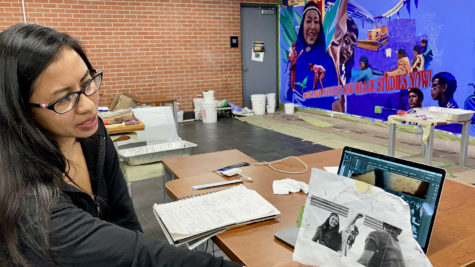
Last year City Times Media spoke to historian Josie Talamante, a former City student who was there that day and has been instrumental in the development of the murals of Chicano Park and preserving the history of Barrio Logan.
The Chicano Studies Department at City was founded that same year – also in response to student activism, according to Justin Akers Chacon, the current chair of the Chicana/o Studies Department.
Akers Chacon described the interconnectedness of the department and Chicano Park.
As the city of San Diego ultimately allowed artists to paint murals celebrating the history and culture of the community, “so we thought it would be appropriate to extend our relationship to that history, especially commemorating 50 years by having our own mural,” Akers Chacon said.
The left-hand portion of the mural also contains the phrase, “Chicano Studies and Black Studies Now!” reflecting activists’ call at the height of the Civil Rights Movement to formally recognize and invest in those disciplines.
The resulting collaboration between champions of both efforts became founding faculty for the two departments that began simultaneously, Akers Chacon said.
That spirit continues to this day and is reflected in the mural.
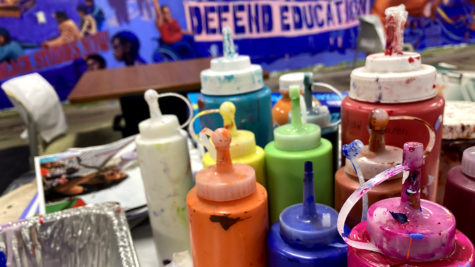
Martinez explained that while the mural was championed by the Chicana/o Studies Department, the group wanted to include the broader context of fighting for social justice and the rights of all oppressed people.
“Black and Brown people experience similar struggles,” Martinez said. “If we fight for our rights, then we also want to fight for the rights of our African American brothers and sisters and our other communities as well – LGBTQ folks, women, et cetera.”
Within the mural, Siu detailed a variety of protests, causes, and personal stories, many based on photographs and descriptions of real events in City’s history of activism with the intention of highlighting the collective as opposed to individuals.
The City College underpass frames marchers surrounding the bridge who represent student groups and mobilizing causes including many related to border issues and immigration – Puente, support for DACA, opposition to ICE raids and California Proposition 187 in 1994, the ballot measure that sought to block services from people without documentation.
Having roots in Central America, Siu said she sees the reasons why people are migrating by the thousands.
“The word migrants to me doesn’t fully represent what migrants are,” she said. “It’s more ‘forced displaced.’”
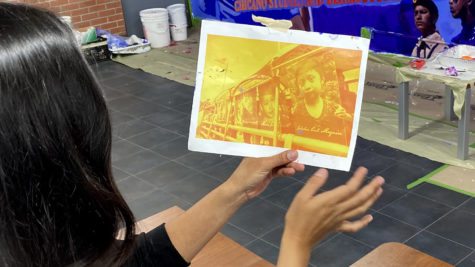
Jakelin Caal Maquin, the 7-year-old Guatemalan girl who died in U.S. Border Patrol custody in 2018, is the first portrait in a yellow-orange filtered row at the top center of the mural.
A representation of one among many.
The group also wanted to include the 2015 #NiUnaMenos (“Not One Less”) campaign in Latin America against gender-based violence, Siu said.
Framed between an upstretched arm and lit candles rests a portrait of City College student Diana Gonzalez, who was brutally murdered on campus by her estranged husband in 2010.
To the left of Gonzalez is a representation of the 43 students from Ayotzinapa Rural Teachers’ College in Mexico who were disappeared in 2014. This led to worldwide protests and the parents of the students came to speak at City, Siu said.
Students also wanted to highlight Black Lives Matter, police brutality and the Kumeyaay “Landback” movement, Siu said. These struggles are woven together with a depiction of the border wall, solidarity against militarization, and families impacted by these divisions. Ongoing issues resulting from colonization form much of the right side of the mural.
While gathering reference photos, the group sought a photo to represent a Kumeyaay woman. Siu found one but could not identify the woman and the group decided they were willing to use it not knowing who she was.
After posting a photo of the work in progress on her Instagram page, someone recognized and tagged the woman, putting Siu in touch with Toni Marie Dominguez and solving the mystery.
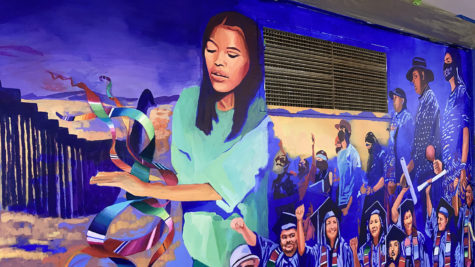
Siu said she apologized to Dominguez for the shock of suddenly finding her lifesize representation in a mural, but Dominguez told Siu she was more shocked by the accurate reflection of her own family’s struggle navigating separation on a day-to-day basis due to border issues imposed upon her homeland.
Referencing the mural, Dominguez told Siu, “I think it worked out perfectly and I’m all for it,” Siu said.
The 49th annual Chicano-Latina Graduation Celebration, which also honored the 2019 retirement of City Professor Cruz Rangel is depicted in the lower right portion of the mural. He helped found the Chicana/o Studies Department and helped start the graduation tradition. The sarape sashes Rangel wove by hand wind throughout the mural, representing pride in cultural heritage.
Even while still in process, the mural contains seemingly endless stories and meaning. These are but a handful of examples while more take shape.
Akers Chacon said a specific public unveiling has not been planned yet, but he anticipates completion of the mural and some type of event this spring, possibly connected to Chicano Graduation.
For now, the work in progress is visible when the cafeteria is open.
“The mural is an art form that has deep roots in Chicano and Mexican history,” Akers Chacon said. “A form of public and accessible art for, in this case, students and the community. It’s also trying to stay loyal to the cultural form that represents many, many generations of history.”
Akers Chacon said the mural speaks to the history, the current moment, and the future.
“The flourishing of the disciplines,” he added, noting the possibility of a Native American Studies professor on the horizon.
On Jan. 20, City President Ricky Shabazz announced the intent of the college to prioritize hiring a Native American Studies professor and to create a scholarship for Indigenous students.
City College has its own history of mural making – from a 2013 student work honoring the life of Diana Gonzalez to the 2021 dedication to former Chancellor Constance Carroll.
City College’s Social Justice Committee also anticipates beginning a mural in April on the AH Building, with the collaboration of students, according to Anna Delgado, an assistant professor of fine art at City.
3B Collective, a group of six artists and designers specializing in mural-making will be seeking input from students on that mural during the 7th Annual Social Justice and Education Conference on Zoom March 23-24, Delgado said.
Delgado also added that a class in public art, which would include mural-making, has been approved at the district level and now moves to the state approval process.
City currently offers a Chicano Art class which includes, “Chicano paintings, murals, prints, sculpture, installation, performance and video,” according to the San Diego Community College District website.
Martinez said the new mural in progress in the cafeteria symbolizes the long legacy of student activism and an acknowledgment of the Chicana/o Studies Department, about which a documentary is also being produced.
“Hopefully Chicano Studies will still be here in 50 more years and a new generation of students and professors,” she said. “This is important for us and for our school.”



